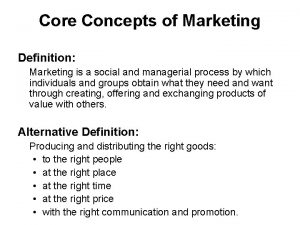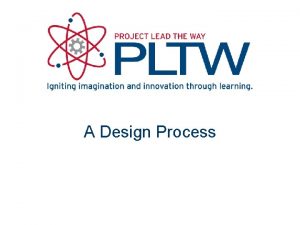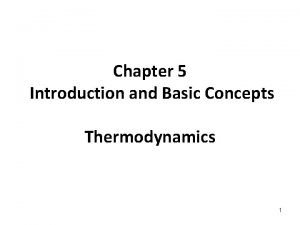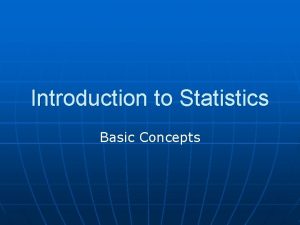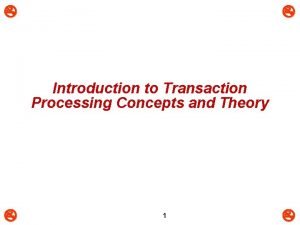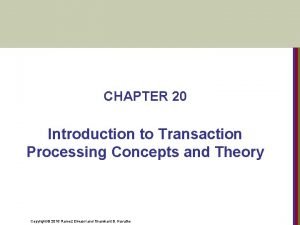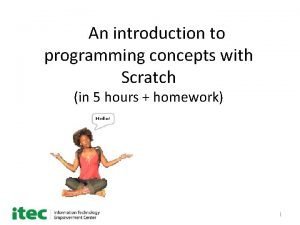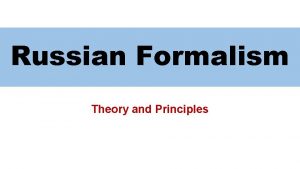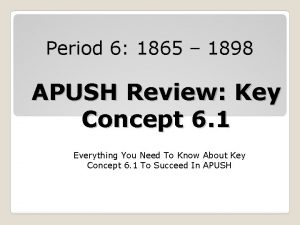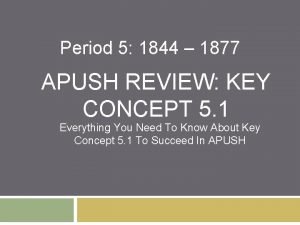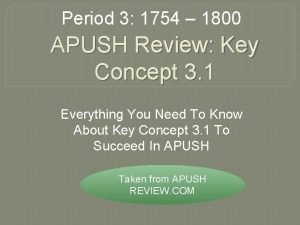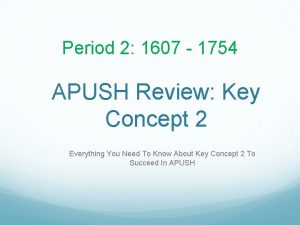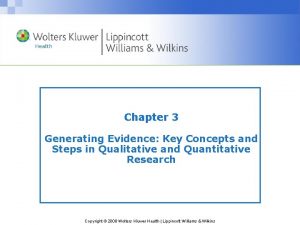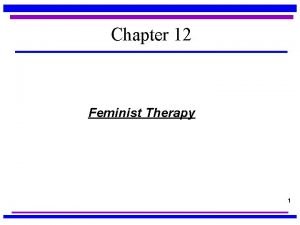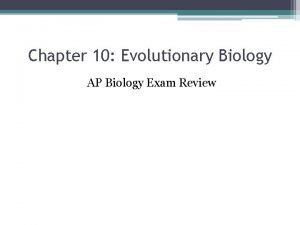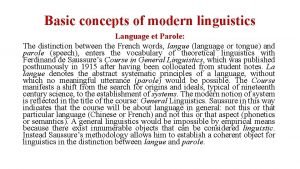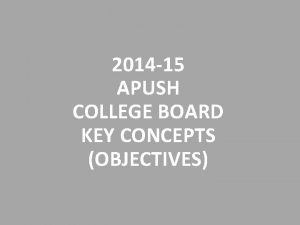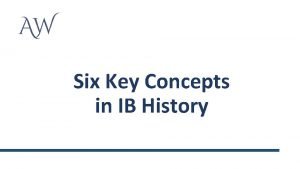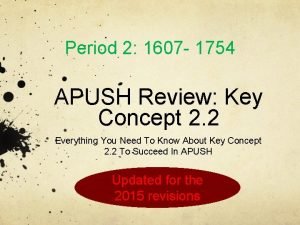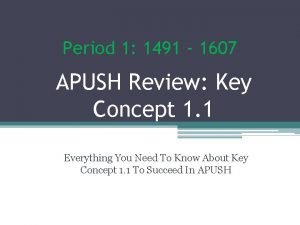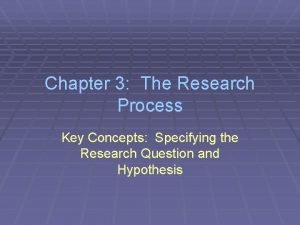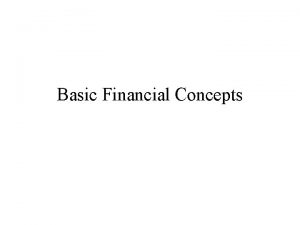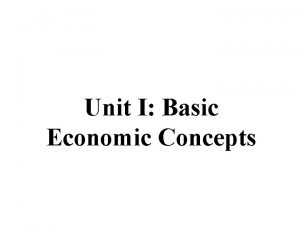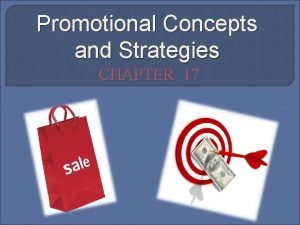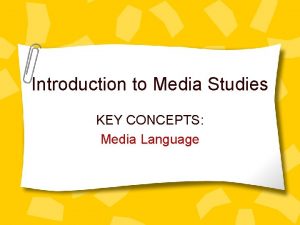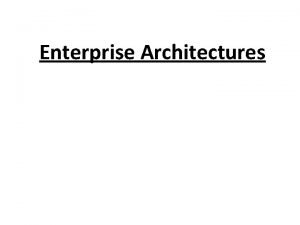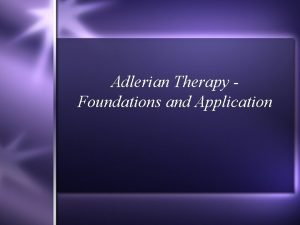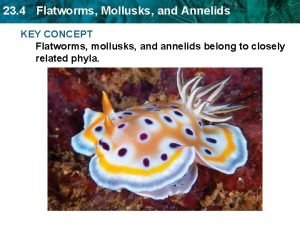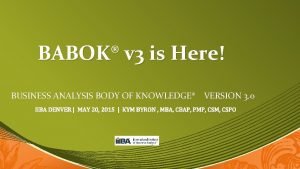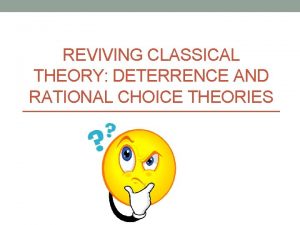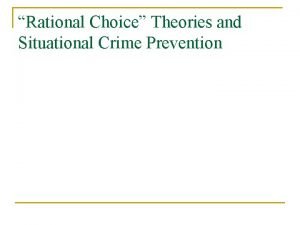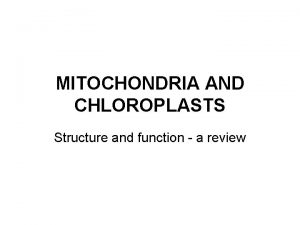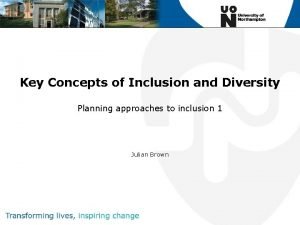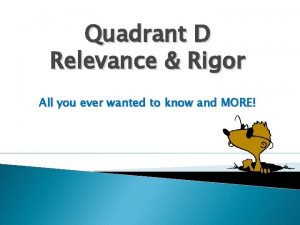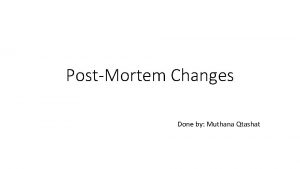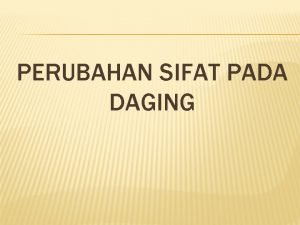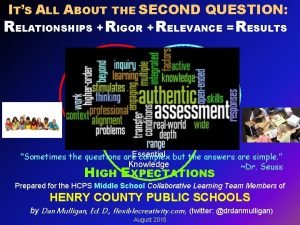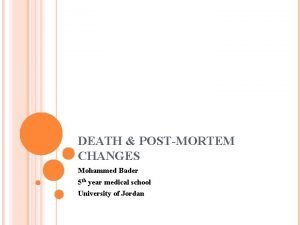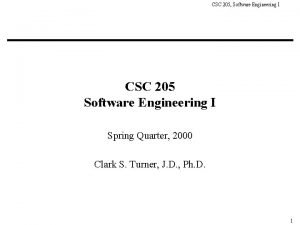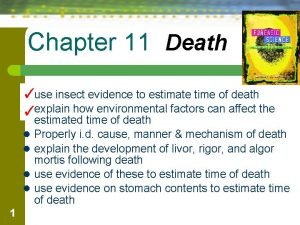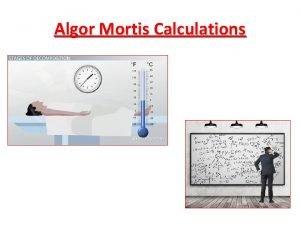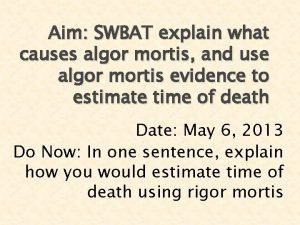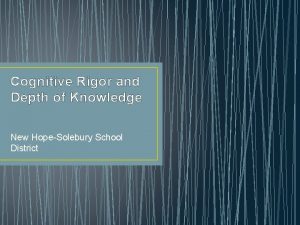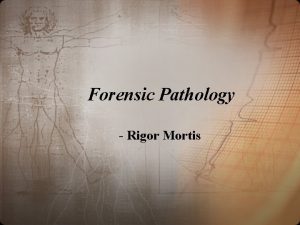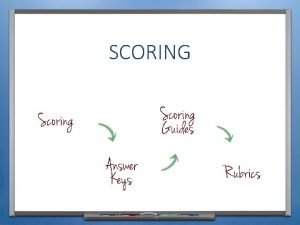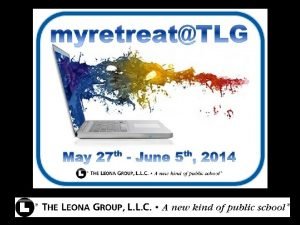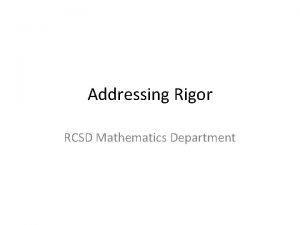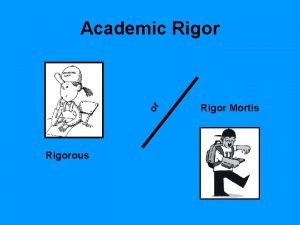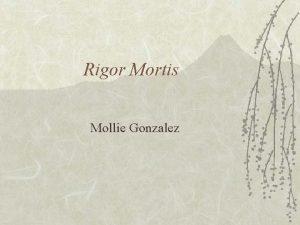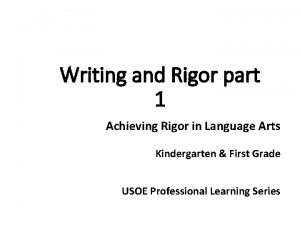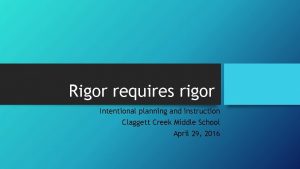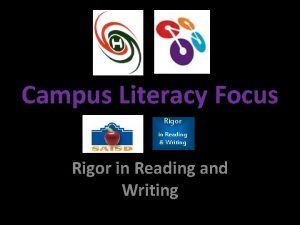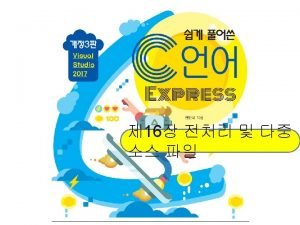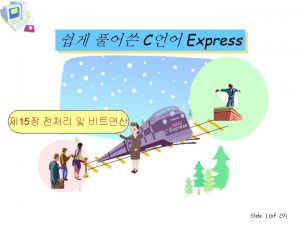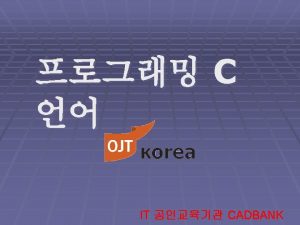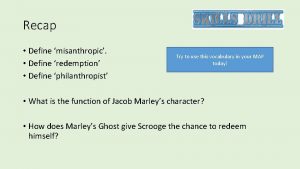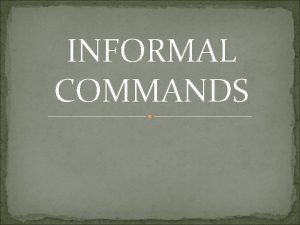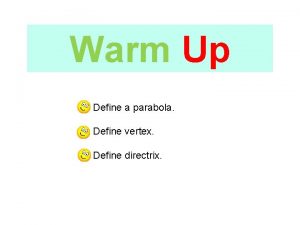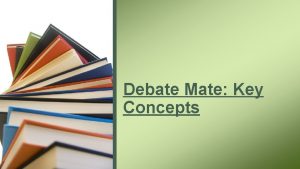RIGOR KEY CONCEPTS INTRODUCTION PURPOSE Define what RIGOR
































































- Slides: 64

RIGOR

KEY CONCEPTS

INTRODUCTION & PURPOSE Define what RIGOR means for the purpose of these modules Use the VERBS in standards and tools that teachers have available to identify the COGNITIVE COMPLEXITY in standards Explain why assessments with an appropriate level of rigor also measure a RANGE OF STUDENT THINKING AND UNDERSTANDING Use the ASSESSMENT BLUEPRINT to document the level of rigor of each skill

KEY CONCEPTS

KEY CONCEPTS rigor the cognitive complexity of a skill within a standard or of an assessment item

KEY CONCEPTS Sources: Kansas State Department of Education, “Assessment Literacy Project”; Ohio Department of Education, “Assessment Literacy: Identifying and Developing Valid and Reliable Assessments” (2013); Relay Graduate School of Education, Designing and Evaluating Assessments (2014); and Rhode Island Department of Education, “Deepening Assessment Literacy. ”

KEY CONCEPTS

KEY CONCEPTS →a →b →c

KEY CONCEPTS Interpret whole-number quotients of whole numbers, e. g. , interpret 56 ÷ 8 as the number of objects in each share when 56 objects are partitioned equally into 8 shares, or as a number of shares when 56 objects are partitioned into equal shares of 8 objects each. For example, describe a context in which a number of shares or a number of groups can be expressed as 56 ÷ 8. Source: Tennessee Department of Education, “Tennessee’s State Mathematics Standards: Grade 3” (2010).

KEY CONCEPTS Interpret whole-number quotients of whole numbers, e. g. , interpret 56 ÷ 8 as the number of objects in each share when 56 objects are partitioned equally into 8 shares, or as a number of shares when 56 objects are partitioned into equal shares of 8 objects each. For example, describe a context in which a number of shares or a number of groups can be expressed as 56 ÷ 8. →Interpret whole-number quotients of whole numbers.

KEY CONCEPTS → Interpret whole-number quotients of whole numbers. What is 12 ÷ 3?

KEY CONCEPTS → Interpret whole-number quotients of whole numbers. What is 12 ÷ 3?

KEY CONCEPTS Interpret whole-number quotients of whole numbers, e. g. , interpret 56 ÷ 8 as the number of objects in each share when 56 objects are partitioned equally into 8 shares, or as a number of shares when 56 objects are partitioned into equal shares of 8 objects each. For example, describe a context in which a number of shares or a number of groups can be expressed as 56 ÷ 8. What is 12 ÷ 3?

KEY CONCEPTS Interpret whole-number quotients of whole numbers, e. g. , interpret 56 ÷ 8 as the number of objects in each share when 56 objects are partitioned equally into 8 shares, or as a number of shares when 56 objects are partitioned into equal shares of 8 objects each. For example, describe a context in which a number of shares or a number of groups can be expressed as 56 ÷ 8. Suppose there are 4 tanks and 3 fish in each tank. The total number of fish in this situation can be expressed as 4 × 3 = 12. a. Describe what is meant in this situation by 12 ÷ 3 = 4 b. Describe what is meant in this situation by 12 ÷ 4 = 3 Source: “Fish Tanks, ” Illustrative Mathematics.

KEY CONCEPTS Suppose there are 4 tanks and 3 fish in each tank. The total number of fish in this situation can be expressed as 4 × 3 = 12. a. Describe what is meant in this situation by 12 ÷ 3 = 4 b. Describe what is meant in this situation by 12 ÷ 4 = 3

KEY CONCEPTS

KEY CONCEPTS Interpret whole-number quotients of whole numbers, e. g. , interpret 56 ÷ 8 as the number of objects in each share when 56 objects are partitioned equally into 8 shares, or as a number of shares when 56 objects are partitioned into equal shares of 8 objects each. For example, describe a context in which a number of shares or a number of groups can be expressed as 56 ÷ 8.

KEY CONCEPTS Interpret whole-number quotients of whole numbers, e. g. , interpret 56 ÷ 8 as the number of objects in each share when 56 objects are partitioned equally into 8 shares, or as a number of shares when 56 objects are partitioned into equal shares of 8 objects each. For example, describe a context in which a number of shares or a number of groups can be expressed as 56 ÷ 8.

KEY CONCEPTS Use the relationship between particular words (e. g. , synonyms, antonyms, homographs) to better understand each of the words. Source: New York State Department of Education, “New York State P-12 Common Core Learning Standards for English Language Arts & Literacy” (2010).

KEY CONCEPTS Use the relationship between particular words (e. g. , synonyms, antonyms, homographs) to better understand each of the words.

KEY CONCEPTS Use the relationship between particular words (e. g. , synonyms, antonyms, homographs) to better understand each of the words.

KEY CONCEPTS Use the relationship between particular words (e. g. , synonyms, antonyms, homographs) to better understand each of the words.

KEY CONCEPTS Use the relationship between particular words (e. g. , synonyms, antonyms, homographs) to better understand each of the words. Which of the following words is an antonym of “tense”? a. troubled b. calm c. concerned d. smooth

KEY CONCEPTS Use the relationship between particular words (e. g. , synonyms, antonyms, homographs) to better understand each of the words. Which of the following words is an antonym of “tense”? a. troubled b. calm c. concerned d. smooth

KEY CONCEPTS Read the passage below. Then answer the question. Last year my family went to a national park for our vacation. We saw wild animals that we had seen only in books, and we were amazed by the landscape of trees and rivers. The highlight of the trip was an arduous hike we took to the top of a small mountain. Though the hike was not easy, due to all the loose rocks and exposed roots on the path, the spectacular view from the top was worth it! What does the word “arduous” mean in this passage? Source: “Part 6 Language, 6. 3 Vocabulary Acquisition and Use: Antonyms, ” The Mc. Graw-Hill Companies.

KEY CONCEPTS Use the relationship between particular words (e. g. , synonyms, antonyms, homographs) to better understand each of the words. Read the passage below. Then answer the question. Last year my family went to a national park for our vacation. We saw wild animals that we had seen only in books, and we were amazed by the landscape of trees and rivers. The highlight of the trip was an arduous hike we took to the top of a small mountain. Though the hike was not easy, due to all the loose rocks and exposed roots on the path, the spectacular view from the top was worth it! What does the word “arduous” mean in this passage?

KEY CONCEPTS

KEY CONCEPTS Draw Memorize Arrange Design Apply Concepts Critique Prove Analyze Create Recall Use Synthesize Define List Illustrate Who, What, When, Where, Why Match Measure Calculate Repeat Connect Identify Tabulate Recognize LEVEL ONE (Recall) Name Categorize Infer Graph Organize Classify LEVEL Modify Describe TWO FOUR Explain Cause/Effect (Skill/ (Extended Interpret Concept) Thinking) Relate Predict LEVEL Compare Interpret THREE (Strategic Estimate Thinking) Summarize Assess Hypothesize Develop a Logical Argument Show Use Concepts to Solve Critique Construct Non-Routine Problems Compare Differentiate Investigate Revise Formulate Draw Conclusions Explain Source: Mississippi Department of Education, Webb’s Depth of Knowledge Guide: Career and Technical Education Definitions (2009).

KEY CONCEPTS Source: Moody, Michael, and Jason Stricker, Strategic Design for Student Achievement (2008).

KEY CONCEPTS

KEY CONCEPTS 1. Remember 2. Understand 3. Apply 4. Analyze 5. Evaluate 6. Create Remember Information Explain Ideas Use Distinguish or Concepts Information Between in a New Parts Way Justify a Create a Position or New Decision Product or Point of View Choose Define Find Identify Label List Match Name Recognize Recall Select Tabulate Classify Compare Describe Estimate Explain Illustrate Infer Interpret Measure Outline Report Summarize Argue Assess Conclude Create Criticize Decide Deduct Defend Judge Predict Prioritize Support Apply Build Calculate Construct Demonstrate Develop Graph Model Organize Practice Solve Use Analyze Attribute Break down Categorize Determine the relationship Differentiate Examine Group Organize Separate Simplify Source: Moody, Michael, and Jason Stricker, Strategic Design for Student Achievement (2008). Adapt Build Combine Design Develop Generate Integrate Modify Plan Produce Theorize Validate

KEY CONCEPTS Which of the following words is an antonym of “tense”? a. troubled b. calm c. concerned d. smooth Read the passage below. Then answer the question. Last year my family went to a national park for our vacation. We saw wild animals that we had seen only in books, and we were amazed by the landscape of trees and rivers. The highlight of the trip was an arduous hike we took to the top of a small mountain. Though the hike was not easy, due to all the loose rocks and exposed roots on the path, the spectacular view from the top was worth it! What does the word “arduous” mean in this passage? 1. Remember 2. Understand 3. Apply Remember Information 4. Analyze Explain Ideas Use Distinguish or Concepts Information Between in a New Parts Way 5. Evaluate 6. Create Justify a Create a Position or New Decision Product or Point of View

KEY CONCEPTS Integrate information presented in different media or formats (e. g. , visually, quantitatively) as well as in words to develop a coherent understanding of a topic or issue. 1. Remember 2. Understand 3. Apply Remember Explain Ideas Use Information or Concepts Information in a New Way 4. Analyze Distinguish Between Parts 5. Evaluate Justify a Position or Decision Choose Define Find Identify Label List Match Name Recognize Repeat Select Tabulate Analyze Break down Categorize Determine the relationship Differentiate Examine Group Organize Separate Simplify Sort Argue Assess Conclude Create Criticize Decide Deduct Defend Judge Predict Prioritize Support Classify Compare Describe Estimate Explain Illustrate Infer Interpret Measure Outline Report Summarize Apply Build Calculate Construct Demonstrate Develop Graph Model Organize Practice Solve Use 6. Create a New Product or Point of View Adapt Build Combine Design Develop Integrate Invent Modify Plan Produce Theorize Validate Source: Rhode Island Department of Education, “Common Core State Standards for English Language Arts & Literacy in History/Social Studies, Science, and Technical Subjects” (2010).

KEY CONCEPTS Integrate information presented in different media or formats (e. g. , visually, quantitatively) as well as in words to develop a coherent understanding of a topic or issue. 1. Remember 2. Understand 3. Apply Remember Information 4. Analyze Explain Ideas Use Distinguish or Concepts Information Between in a New Parts Way 5. Evaluate 6. Create Justify a Create a Position or New Decision Product or Point of View

KEY CONCEPTS

KEY CONCEPTS

KEY CONCEPTS

KEY CONCEPTS The student solves problems involving direct proportional relationships. The student is expected to estimate and find solutions to application problems involving percent; and estimate and find solutions to application problems involving proportional relationships such as similarity, scaling, unit costs, and related measurement units. Source: Texas Education Agency Student Assessment Division, “Grade 7 Mathematics Assessment” (2010).

KEY CONCEPTS The student solves problems involving direct proportional relationships. The student is expected to estimate and find solutions to application problems involving percent; and estimate and find solutions to application problems involving proportional relationships such as similarity, scaling, unit costs, and related measurement units.

KEY CONCEPTS 1. What is 67 percent of 81? 2. Shawn got 7 correct answers out of 10 possible answers on his science test. What percentage of questions did he answer correctly? 3. Adam was on pace to set a high-school basketball record for free throw percentage. Going into his senior year, he had made 97 of 104 free throw attempts. What percentage of free throws had he made? 4. Adam and Jamie were competing for the best free throw percentage. Adam made 94 percent of his first 103 shots, whereas Jamie made 47 of 51 shots. a. Which one had a better shooting percentage? b. In the next game, Adam made only 2 of 10 shots, and Jamie made 7 of 10 shots. What are their new overall shooting percentages? Who is the better shooter? c. Christine argued that if Adam and Jamie each made their next 10 shots, their shooting percentages would go up the same amount. Is this true? Why or why not? Describe in detail how you arrived at your answers. Source: Paul Bambrick-Santoyo, “Data in the Driver’s Seat” (2007– 2008).

KEY CONCEPTS The student solves problems involving direct proportional relationships. The student is expected to estimate and find solutions to application problems involving percent; and estimate and find solutions to application problems involving proportional relationships such as similarity, scaling, unit costs, and related measurement units.

KEY CONCEPTS

KEY CONCEPTS Sources: Ohio Department of Education, “Ohio’s New Learning Standards: English Language Standards” (2010); Student Achievement Partners, “Mini-Assessment for Who Was Marco Polo? by Joan Holub and The Adventures of Marco Polo by Russell Freedman” (2014).

KEY CONCEPTS

KEY CONCEPTS 1. Primary Purpose of the Assessment Summative 2. Standard(s) (one per row) 3. Skill(s) (one per row) 4. Level(s) of Rigor 5. Possible Type(s) of Items Reading Informational Text 1: Quote accurately from a text when explaining what the text says explicitly and when drawing inferences from the text. Quote accurately from the text (explicitly and making inferences). Level(s) of Rigor # of Points % of Assessment Identify main ideas and Reading Informational Text 2: Determine two or more main ideas of a text and explain how key details support how they are supported by key details; summarize the text. them. Reading Informational Text 4: Determine the meaning of general academic and domainspecific words and phrases in a text relevant to a grade 5 topic or subject area. Determine the meaning of new vocabulary words. Reading Informational Text 8: Explain how an author uses reasons and evidence to support particular points in a text, identifying which reasons and evidence support which point(s). Explain how the author uses evidence to support his or her claims. Write an opinion piece on texts. Writing 1: Write opinion pieces on topics or texts, supporting a point of view with reasons and information. Support your point of view with evidence. 6. Write and/or Select Assessment Items Item # TOTAL Standard(s) and/or Skill(s) Type of Item

KEY CONCEPTS 1. Primary Purpose of the Assessment Summative 2. Standard(s) (one per row) 3. Skill(s) (one per row) 4. Level(s) of Rigor 5. Possible Type(s) of Items Reading Informational Text 1: Quote accurately from a text when explaining what the text says explicitly and when drawing inferences from the text. Quote accurately from the text (explicitly and making inferences). Level(s) of Rigor # of Points % of Assessment Identify main ideas and Reading Informational Text 2: Determine two or more main ideas of a text and explain how key details support how they are supported by key details; summarize the text. them. Reading Informational Text 4: Determine the meaning of general academic and domainspecific words and phrases in a text relevant to a grade 5 topic or subject area. Determine the meaning of new vocabulary words. Reading Informational Text 8: Explain how an author uses reasons and evidence to support particular points in a text, identifying which reasons and evidence support which point(s). Explain how the author uses evidence to support his or her claims. Write an opinion piece on texts. Writing 1: Write opinion pieces on topics or texts, supporting a point of view with reasons and information. Support your point of view with evidence. 6. Write and/or Select Assessment Items Item # TOTAL Standard(s) and/or Skill(s) Type of Item

KEY CONCEPTS 3. Skill(s) (one per row) 4. Level(s) of Rigor Quote accurately from the text (explicitly and making inferences). Identify main ideas and how key details support them. Determine the meaning of new vocabulary words. Explain how the author uses evidence to support his or her claims. Write an opinion piece on texts. Support your point of view with evidence.

KEY CONCEPTS 3. Skill(s) (one per row) Quote accurately from the text (explicitly and making inferences). Identify main ideas and how key details support them. Determine the meaning of new vocabulary words. Explain how the author uses evidence to support his or her claims. Write an opinion piece on texts. Support your point of view with evidence. 1. Remember 2. Understand 3. Apply Remember Information 4. Level(s) of Rigor 4. Analyze 5. Evaluate 6. Create Explain Ideas Use Distinguish Justify a or Concepts Information Between Position in a New Parts or Way Decision Create a New Product or Point of View

KEY CONCEPTS 1. Primary Purpose of the Assessment Summative 2. Standard(s) (one per row) 3. Skill(s) (one per row) 4. Level(s) of Rigor Reading Informational Text 1: Quote accurately from a text when explaining what the text says explicitly and when drawing inferences from the text. Quote accurately from the text (explicitly and making inferences). 1 Identify main ideas and Reading Informational Text 2: Determine two or more main ideas of a text and explain how key details support how they are supported by key details; summarize the text. them. 2 Reading Informational Text 4: Determine the meaning of general academic and domainspecific words and phrases in a text relevant to a grade 5 topic or subject area. Determine the meaning of new vocabulary words. 2 Reading Informational Text 8: Explain how an author uses reasons and evidence to support particular points in a text, identifying which reasons and evidence support which point(s). Explain how the author uses evidence to support his or her claims. 4 Write an opinion piece on texts. 5 Support your point of view with evidence. 5 Level(s) of Rigor # of Points Writing 1: Write opinion pieces on topics or texts, supporting a point of view with reasons and information. 5. Possible Type(s) of Items 6. Write and/or Select Assessment Items Item # TOTAL Standard(s) and/or Skill(s) Type of Item % of Assessment

KEY CONCEPTS 1. Primary Purpose of the Assessment Summative 2. Standard(s) (one per row) 3. Skill(s) (one per row) 4. Level(s) of Rigor Reading Informational Text 1: Quote accurately from a text when explaining what the text says explicitly and when drawing inferences from the text. Quote accurately from the text (explicitly and making inferences). 1 Identify main ideas and Reading Informational Text 2: Determine two or more main ideas of a text and explain how key details support how they are supported by key details; summarize the text. them. 2 Reading Informational Text 4: Determine the meaning of general academic and domainspecific words and phrases in a text relevant to a grade 5 topic or subject area. Determine the meaning of new vocabulary words. 2 Reading Informational Text 8: Explain how an author uses reasons and evidence to support particular points in a text, identifying which reasons and evidence support which point(s). Explain how the author uses evidence to support his or her claims. 4 Write an opinion piece on texts. 5 Writing 1: Write opinion pieces on topics or texts, supporting a point of view with reasons and information. Support your point of view with evidence. 5 Level(s) of Rigor # of Points 5. Possible Type(s) of Items 6. Write and/or Select Assessment Items Item # TOTAL Standard(s) and/or Skill(s) Type of Item % of Assessment

KEY CONCEPTS

KEY CONCEPTS 1. Primary Purpose of the Assessment Summative 2. Standard(s) (one per row) 3. Skill(s) (one per row) 4. Level(s) of Rigor 5. Possible Type(s) of Items Reading Informational Text 1: Quote accurately from a text when explaining what the text says explicitly and when drawing inferences from the text. Quote accurately from the text (explicitly and making inferences). 1 SR Identify main ideas and Reading Informational Text 2: Determine two or more main ideas of a text and explain how key details support how they are supported by key details; summarize the text. them. 2 CR Reading Informational Text 4: Determine the meaning of general academic and domainspecific words and phrases in a text relevant to a grade 5 topic or subject area. Determine the meaning of new vocabulary words. 2 SR Reading Informational Text 8: Explain how an author uses reasons and evidence to support particular points in a text, identifying which reasons and evidence support which point(s). Explain how the author uses evidence to support his or her claims. 4 CR Write an opinion piece on texts. 5 CR, PT Support your point of view with evidence. 5 CR, PT Level(s) of Rigor # of Points % of Assessment Writing 1: Write opinion pieces on topics or texts, supporting a point of view with reasons and information. 6. Write and/or Select Assessment Items Item # TOTAL Standard(s) and/or Skill(s) Type of Item

KEY CONCEPTS 1. Primary Purpose of the Assessment Summative 2. Standard(s) (one per row) 3. Skill(s) (one per row) 4. Level(s) of Rigor 5. Possible Type(s) of Items Reading Informational Text 1: Quote accurately from a text when explaining what the text says explicitly and when drawing inferences from the text. Quote accurately from the text (explicitly and making inferences). 1 SR Identify main ideas and Reading Informational Text 2: Determine two or more main ideas of a text and explain how key details support how they are supported by key details; summarize the text. them. 2 CR Reading Informational Text 4: Determine the meaning of general academic and domainspecific words and phrases in a text relevant to a grade 5 topic or subject area. Determine the meaning of new vocabulary words. 2 SR Reading Informational Text 8: Explain how an author uses reasons and evidence to support particular points in a text, identifying which reasons and evidence support which point(s). Explain how the author uses evidence to support his or her claims. 4 CR Write an opinion piece on texts. 5 CR, PT Writing 1: Write opinion pieces on topics or texts, supporting a point of view with reasons and information. Support your point of view with evidence. 5 CR, PT Level(s) of Rigor # of Points % of Assessment 6. Write and/or Select Assessment Items Item # TOTAL Standard(s) and/or Skill(s) Type of Item

KEY CONCEPTS

CHECK FOR UNDERSTANDING

CHECK FOR UNDERSTANDING Define what RIGOR means for the purpose of these modules Use the VERBS in standards and tools that teachers have available to identify the COGNITIVE COMPLEXITY in standards Explain why assessments with an appropriate level of rigor also measure a RANGE OF STUDENT THINKING AND UNDERSTANDING Use the ASSESSMENT BLUEPRINT to document the level of rigor of each skill

CHECK FOR UNDERSTANDING

CHECK FOR UNDERSTANDING 1. Using Bloom’s Taxonomy, identify the level or levels of rigor in this standard from Iowa. Remember to pay close attention to the verbs. Understand the use of geographic tools to locate and analyze information about people, places, and environments. 1. Remember 2. Understand 3. Apply 4. Analyze Remember Information Explain Ideas or Concepts Use Distinguish Justify a Create a Information Between Parts Position or New in a New Way Decision Product or Point of View Source: Iowa Department of Education, “Iowa Core K-12 Social Studies” (2010). 5. Evaluate 6. Create

CHECK FOR UNDERSTANDING 1. Using Bloom’s Taxonomy, identify the level or levels of rigor in this standard from Iowa. Remember to pay close attention to the verbs. Understand the use of geographic tools to locate and analyze information about people, places, and environments. 1. Remember 2. Understand 3. Apply Remember Information 4. Analyze 5. Evaluate 6. Create Explain Ideas Use Distinguish Justify a or Concepts Information Between Position in a New Parts or Way Decision Create a New Product or Point of View

CHECK FOR UNDERSTANDING 1. Using Bloom’s Taxonomy, identify the level or levels of rigor in this standard from Iowa. Remember to pay close attention to the verbs. Understand the use of geographic tools to locate and analyze information about people, places, and environments. The key verbs in the skills in this standard are “use” and “analyze, ” which are associated with lower- and higher-order skills. “Understand” is a level 1 skill, and “analyze” is a level 4 skill.

CHECK FOR UNDERSTANDING 2. Explain in your own words why well-designed assessments should measure a range of student thinking and understanding.

CHECK FOR UNDERSTANDING 2. Explain in your own words why well-designed assessments should measure a range of student thinking and understanding.

CHECK FOR UNDERSTANDING 2. Explain in your own words why well-designed assessments should measure a range of student thinking and understanding. Well-designed assessments include items with various levels of rigor to ensure that they measure what all students know and can do. If assessments are too easy, some students may not have the opportunity to demonstrate the upper bounds of what they know and can do. I should include items in my assessment that challenge all of my students. On the other hand, if assessments are too complex, some students may not be able to showcase their knowledge and skills at all. I can include items that require lower-level thinking to reveal where learning breaks down among students struggling to master a standard.

CONCLUSION
 What are key activities in a business model
What are key activities in a business model Contoh bisnis model canvas makanan pdf
Contoh bisnis model canvas makanan pdf The core concepts of marketing
The core concepts of marketing Design process used in ied
Design process used in ied Define financial concepts
Define financial concepts Introduction and basic concepts of thermodynamics
Introduction and basic concepts of thermodynamics Thermodynamics introduction and basic concepts
Thermodynamics introduction and basic concepts Introduction to statistics and some basic concepts
Introduction to statistics and some basic concepts Introduction to marketing concepts
Introduction to marketing concepts Introduction to transaction processing concepts and theory
Introduction to transaction processing concepts and theory Introduction and mathematical concepts
Introduction and mathematical concepts Physics chapter 1 introduction and mathematical concepts
Physics chapter 1 introduction and mathematical concepts Introduction to transaction processing concepts and theory
Introduction to transaction processing concepts and theory Introduction to programming concepts with scratch
Introduction to programming concepts with scratch Literariness in russian formalism
Literariness in russian formalism Key concepts examples
Key concepts examples Period 6 apush key concepts
Period 6 apush key concepts Period 5 key concepts apush
Period 5 key concepts apush Apush review.com
Apush review.com Apush key concepts period 2
Apush key concepts period 2 Key concepts in qualitative research
Key concepts in qualitative research Feminist therapy key concepts
Feminist therapy key concepts Reviewing key concepts reproductive barriers
Reviewing key concepts reproductive barriers Parole vs langue
Parole vs langue Jeremiad apush
Jeremiad apush Apush college board key concepts
Apush college board key concepts Ib historical concepts
Ib historical concepts Apush key concepts period 2
Apush key concepts period 2 Apush key concepts period 1
Apush key concepts period 1 Key concepts in research
Key concepts in research Basic finance concepts
Basic finance concepts Detente apush
Detente apush Unit 1: basic economic concepts answer key
Unit 1: basic economic concepts answer key Promotional concepts and strategies
Promotional concepts and strategies David hesmondhalgh theory
David hesmondhalgh theory Enterprise architecture key concepts
Enterprise architecture key concepts Adlerian therapy example
Adlerian therapy example Section 4 flatworms mollusks and annelids
Section 4 flatworms mollusks and annelids Business analysis core concept model
Business analysis core concept model Specific deterrence
Specific deterrence Rational choice theory key concepts
Rational choice theory key concepts Structure and function of mitochondria
Structure and function of mitochondria Culturalism
Culturalism Key concepts in operations management
Key concepts in operations management Key concepts of diversity
Key concepts of diversity Purpose sentence
Purpose sentence Specific purpose statements
Specific purpose statements Autolysis
Autolysis Rigor relevance and relationships
Rigor relevance and relationships Quadrant d
Quadrant d Rigor
Rigor Hypo stasis
Hypo stasis Late postmortem changes
Late postmortem changes Apa itu pre rigor
Apa itu pre rigor Why does rigor mortis occur
Why does rigor mortis occur Relationships before rigor
Relationships before rigor Relationships before rigor
Relationships before rigor Bader5
Bader5 Rigor mortis eyes
Rigor mortis eyes Rigor and formality
Rigor and formality Site:slidetodoc.com
Site:slidetodoc.com Algor mortis calculator
Algor mortis calculator Rigor mortis worksheet
Rigor mortis worksheet What is cognitive rigor
What is cognitive rigor Scientific rigor definition
Scientific rigor definition


